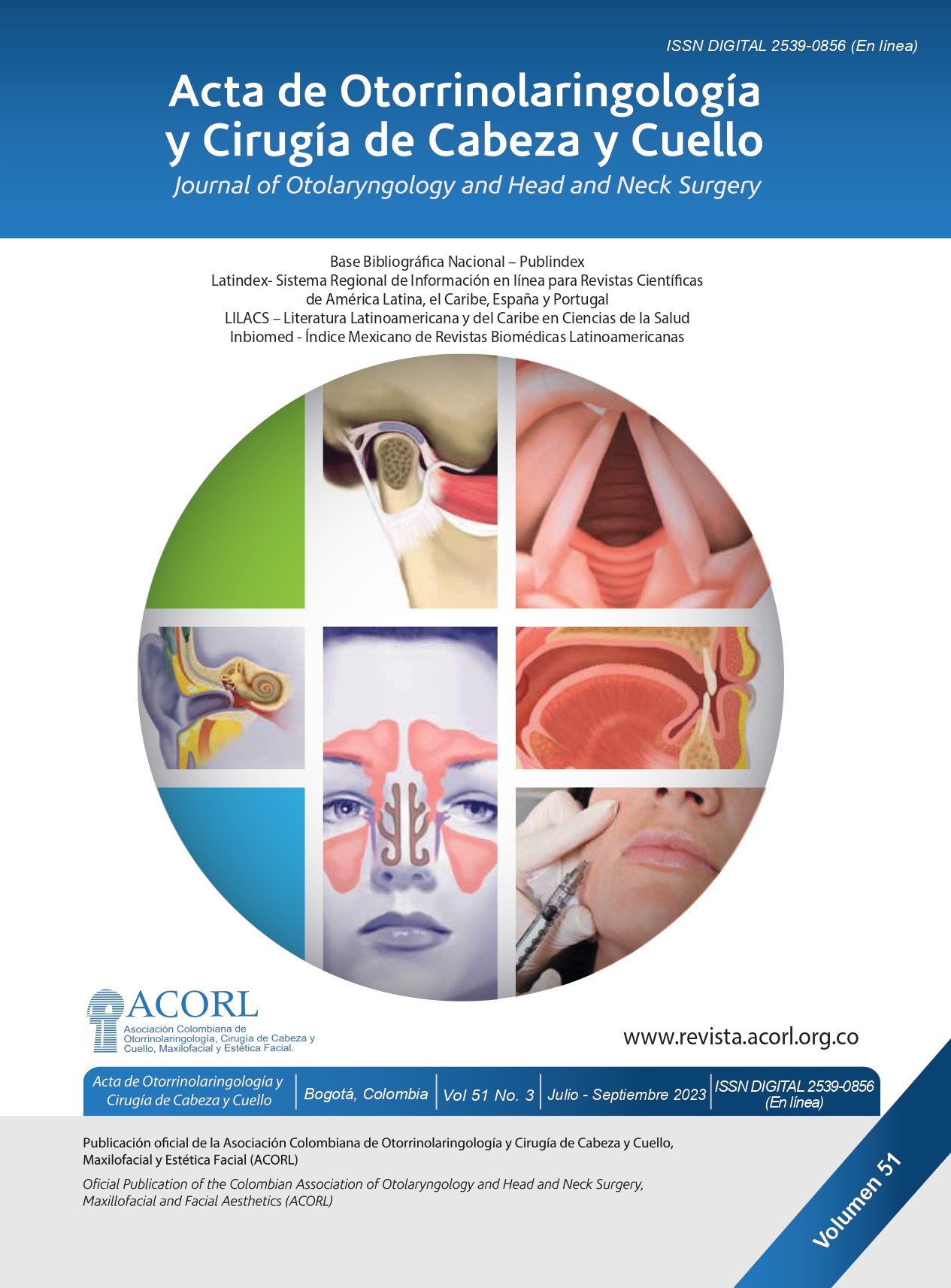Patrones de neumatización del seno esfenoidal en la tomografía computarizada como parte de la evaluación preoperatoria para cirugía endoscópica transesfenoidal
Contenido principal del artículo
Resumen
Introducción: la determinación del patrón de neumatización del seno esfenoidal (SE) y su relación con estructuras neurovasculares en el análisis tomográfico preoperatorio provee un mayor entendimiento de la anatomía para minimizar el riesgo intraoperatorio potencial sobre estructuras vitales. El objetivo de este estudio fue estimar la frecuencia de presentación de los diferentes tipos de neumatización del SE, protrusión/dehiscencia de la arteria carótida interna (ACI), septación intersinusal y neumatización “aberrante” en la evaluación de tomografía computarizada (TC) de senos paranasales en el Hospital Militar Central de Bogotá. Metodología: estudio observacional descriptivo de corte transversal que revisó 756 tomografías, de estas seleccionó aleatoriamente 422. Se estimó la frecuencia de presentación de cada tipo de neumatización del SE. Los hallazgos fueron analizados con estadística descriptiva. Resultados: el tipo de neumatización más frecuente utilizando la clasificación Güldner y colaboradores fue el tipo postsellar IVa, seguido del sellar y postsellar IVb. La protrusión y dehiscencia de la ACI estuvieron ambas más comúnmente presentes en los tipos de neumatización más extensa del SE, así como los patrones de neumatización “aberrante”. El patrón de septación múltiple predominó en 86,3 % de los casos. Conclusiones: el análisis de la tomografía preoperatoria para cirugía endoscópica transesfenoidal es fundamental para reconocer el tipo de neumatización del SE y sus variantes, lo que permite minimizar el riesgo de lesionar estructuras vitales. La mayor extensión de la neumatización se relaciona con mayor frecuencia de variantes de riesgo de la ACI, estos tipos de neumatización más extensa predominaron en este estudio.
Detalles del artículo
Sección

Esta obra está bajo una licencia internacional Creative Commons Atribución-CompartirIgual 4.0.
Este artículo es publicado por la Revista Acta de Otorrinolaringología & Cirugía de Cabeza y Cuello.
Este es un artículo de acceso abierto, distribuido bajo los términos de la LicenciaCreativeCommons Atribución-CompartirIgual 4.0 Internacional.( http://creativecommons.org/licenses/by-sa/4.0/), que permite el uso no comercial, distribución y reproducción en cualquier medio, siempre que la obra original sea debidamente citada.
eISSN: 2539-0856
ISSN: 0120-8411
Cómo citar
Referencias
García-Garrigós E, Arenas-Jiménez JJ, Monjas-Cánovas I, Abarca-Olivas J, Cortés-Vela JJ, De La Hoz-Rosa J, et al. Transsphenoidal Approach in Endoscopic Endonasal Surgery for Skull Base Lesions: What Radiologists and Surgeons Need to Know. Radiographics. 2015;35(4):1170-85. doi: 10.1148/ rg.2015140105
Wiebracht ND, Zimmer LA. Complex anatomy of the sphenoid sinus: a radiographic study and literature review. J Neurol Surg B Skull Base. 2014;75(6):378-82. doi: 10.1055/s-0034- 1376195
Famurewa OC, Ibitoye BO, Ameye SA, Asaleye CM, Ayoola OO, Onigbinde OS. Sphenoid Sinus Pneumatization, Septation, and the Internal Carotid Artery: A Computed Tomography Study. Niger Med J. 2018;59(1):7-13. doi: 10.4103/nmj.NMJ_138_18
Locatelli M, Di Cristofori A, Draghi R, Bertani G, Guastella C, Pignataro L, et al. Is Complex Sphenoidal Sinus Anatomy a Contraindication to a Transsphenoidal Approach for Resection of Sellar Lesions? Case Series and Review of the Literature. World Neurosurg. 2017;100:173-79. doi: 10.1016/j. wneu.2016.12.123
Jiang WH, Xiao JY, Zhao SP, Xie ZH, Zhang H. Resection of extensive sellar tumors with extended endoscopic transseptal transsphenoidal approach. Eur Arch Otorhinolaryngol. 2007;264(11):1301-8. doi: 10.1007/s00405-007-0360-7
Learned KO, Lee JYK, Adappa ND, Palmer JN, Newman JG, Mohan S, et al. Radiologic Evaluation for Endoscopic Endonasal Skull Base Surgery Candidates. Neurographics. 2015;5(2):41-55. doi: 10.3174/ng.2150110
Güldner C, Pistorius SM, Diogo I, Bien S, Sesterhenn A, Werner JA. Analysis of pneumatization and neurovascular structures of the sphenoid sinus using cone-beam tomography (CBT). Acta Radiol. 2012;53(2):214-9. doi: 10.1258/ar.2011.110381
Raseman J, Guryildirim M, Beer-Furlan A, Jhaveri M, Tajudeen BA, Byrne RW, et al. Preoperative Computed Tomography Imaging of the Sphenoid Sinus: Striving Towards Safe Transsphenoidal Surgery. J Neurol Surg B Skull Base. 2020;81(3):251-62. doi: 10.1055/s-0039-1691831
Hardy J. La chirurgie de l’hypophyse par voie trans-sphénoidale ouverte. Etude comparative de deux modalités techniques [Surgery of the pituitary gland, using the open trans-sphenoidal approach. Comparative study of 2 technical methods]. Ann Chir. 1967;21(15):1011-22.
Hamid O, El Fiky L, Hassan O, Kotb A, El Fiky S. Anatomic Variations of the Sphenoid Sinus and Their Impact on Trans sphenoid Pituitary Surgery. Skull Base. 2008;18(1):9-15. doi: 10.1055/s-2007-992764
Tomovic S, Esmaeili A, Chan NJ, Shukla PA, Choudhry OJ, Liu JK, et al. High-resolution computed tomography analysis of variations of the sphenoid sinus. J Neurol Surg B Skull Base. 2013;74(2):82-90. doi: 10.1055/s-0033-1333619
Movahhedian N, Paknahad M, Abbasinia F, Khojatepour L. Cone Beam Computed Tomography Analysis of Sphenoid Sinus Pneumatization and Relationship with Neurovascular Structures. J Maxillofac Oral Surg. 2021;20(1):105-14. doi: 10.1007/s12663-020-01326-x
Lu Y, Pan J, Qi S, Shi J, Zhang X, Wu K. Pneumatization of the sphenoid sinus in Chinese: the differences from Caucasian and its application in the extended transsphenoidal approach. J Anat. 2011;219(2):132-42. doi: 10.1111/j.1469-7580.2011.01380.x
Batra PS, Citardi MJ, Gallivan RP, Roh HJ, Lanza DC. Software enabled CT analysis of optic nerve position and paranasal sinus pneumatization patterns. Otolaryngol Head Neck Surg. 2004;131(6):940-5. doi: 10.1016/j.otohns.2004.07.013
Stokovic N, Trkulja V, Dumic-Cule I, Cukovic-Bagic I, Lauc T, Vukicevic S, et al. Sphenoid sinus types, dimensions and relationship with surrounding structures. Ann Anat. 2016;203:69-76. doi: 10.1016/j.aanat.2015.02.013
Rahmati A, Ghafari R, AnjomShoa M. Normal Variations of Sphenoid Sinus and the Adjacent Structures Detected in Cone Beam Computed Tomography. J Dent (Shiraz). 2016;17(1):32-7.
Idowu OE, Balogun BO, Okoli CA. Dimensions, septation, and pattern of pneumatization of the sphenoidal sinus. Folia Morphol (Warsz). 2009;68(4):228-32.
Refaat R, Basha MAA. The impact of sphenoid sinus pneumatization type on the protrusion and dehiscence of the adjacent neurovascular structures: A prospective MDCT imaging study. Acad Radiol. 2020;27(6):e132-e139. doi: 10.1016/j.acra.2019.09.005
Dal Secchi MM, Dolci RLL, Teixeira R, Lazarini PR. An Analysis of Anatomic Variations of the Sphenoid Sinus and Its Relationship to the Internal Carotid Artery. Int Arch Otorhinolaryngol. 2018;22(2):161-66. doi: 10.1055/s-0037- 1607336
Unal B, Bademci G, Bilgili YK, Batay F, Avci E. Risky anatomic variations of sphenoid sinus for surgery. Surg Radiol Anat. 2006;28(2):195-201. doi: 10.1007/s00276-005-0073-9
Cappello ZJ, Minutello K, Dublin AB. Anatomy, Head and Neck, Nose Paranasal Sinuses. [Actualizado el 11 de febrero de 2023]. En: StatPearls [Internet]. Treasure Island (FL): StatPearls Publishing; 2023. Disponible en: https://www.ncbi. nlm.nih.gov/books/NBK499826/





